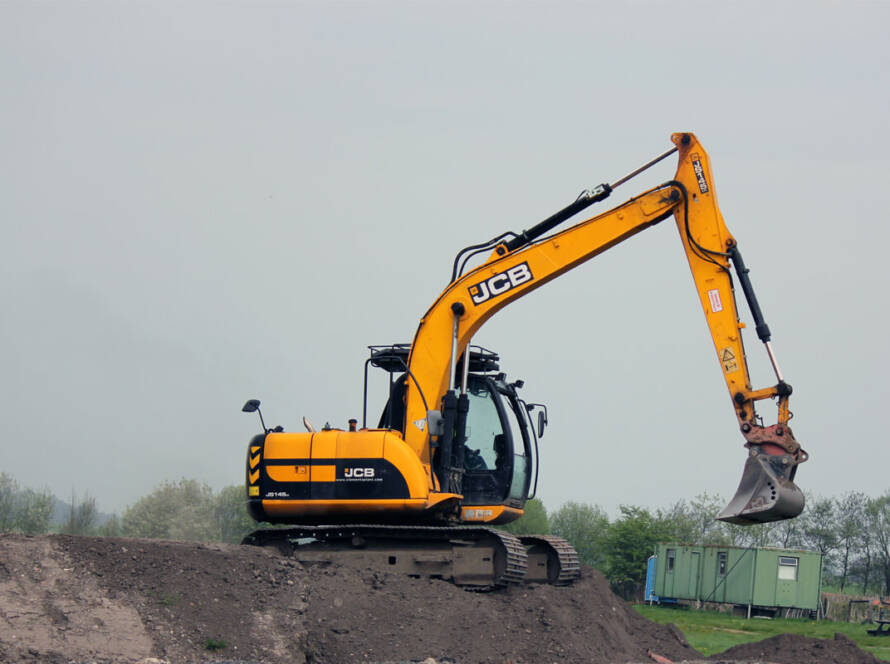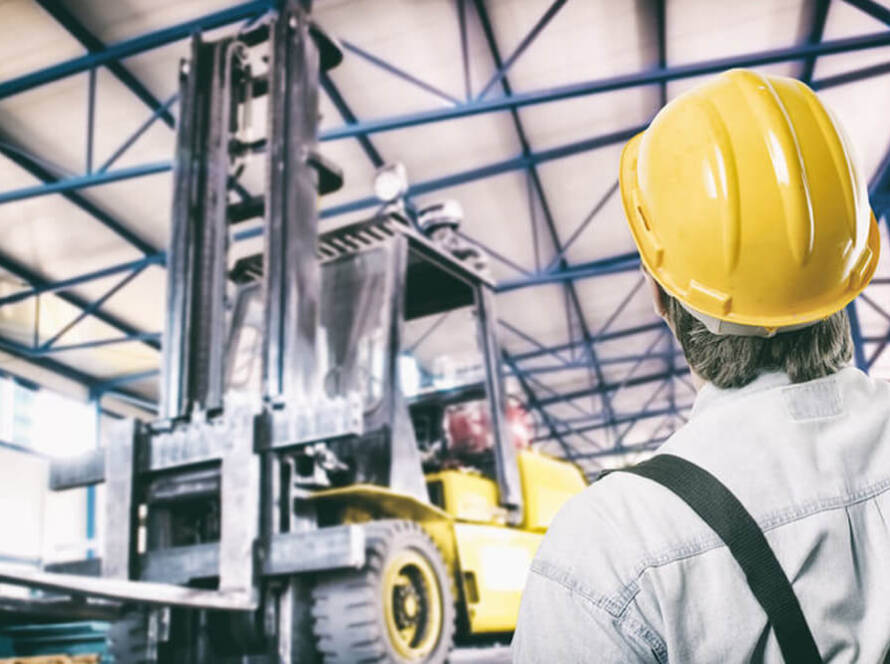If you work in the construction industry, you are likely to use machinery and equipment that help to lift, carry, and move heavy loads daily.
Lifting equipment and machinery assists those working in construction, warehouses, and factories to complete projects quickly, efficiently, and safely.
The most common types of lifting equipment used in the construction industry are the forklift and the telehandler.
While some people use these names interchangeably, they are not the same.
In construction and warehousing industries, selecting the wrong piece of equipment for the job can be a dangerous and expensive error. Therefore, it’s important to understand the differences.
In this article, we will find out more about the functionalities and capabilities of each, the differences between the two, and their advantages.
Different types of telehandler and forklift
When comparing forklifts and telehandlers, it’s important to remember that there are different types of each. The right piece of equipment for the job depends on the load that is to be lifted and the terrain and environment the job is being carried out in.
Types of forklift
Forklifts are key pieces of equipment in both construction sites and warehouses. However, the most appropriate type of forklift for the job varies from one environment to the next, depending on what the project’ requirements are. There are over 20 types of forklift, each with different capabilities.
The most popular types of forklift are:
- Counterbalance forklift – Also for use in warehouses, the counterbalance forklift does not have outrigger arms, allowing it to easily manoeuvre around warehouse racking. This type of forklift uses a weight to counterbalance the load it is lifting. Able to lift up to 30,000 lbs, these heavy-duty counterbalance forklifts are most often used by industries and warehouses.
- Rough terrain forklift – Large, pneumatic tyres and a powerful engine make the rough terrain forklift ideal for working outside on rough or uneven terrain.
- Side loader forklift – Ideal for working inside in narrow areas and lifting long objects, these forklifts have forks attached to their side instead of their front.
- Reach forklift – Usually used inside warehouses, the reach forklift has an extended height and can reach up to 10 metres.
Types of telehandler
Telehandlers, sometimes also referred to as telescopic forklifts, are more suited to outdoor locations and construction sites.
The three main types of telehandler are:
- Fixed boom rough terrain telehandler – This is the most common type of telehandler, it features a fixed cab and a standard boom.
- Rotating telehandler – The cab and attached boom can be rotated 360 degrees on a rotating telehandler, making this piece of equipment both versatile and efficient.
- Heavy-duty telehandler – If you require more power, heavy-duty telehandlers can lift weights of up to 16,000 lbs.
Telehandler versus forklift
Both forklifts and telehandlers are used to lift and move heavy or bulky loads. There are however key differences between the capabilities of the two and the setting that they’re best suited to working in.
- Attachments – The forklift features a simple fork attachment that it uses to lift loads. There are different attachments available for forklifts, but the variety is limited. The telehandler is a more flexible piece of equipment that features a boom that can have many different attachments fitted including pallet forks, hooks, scoops, and buckets, allowing it to lift a greater variety of loads.
- Manoeuvrability – Forklifts are generally smaller and more compact than telehandlers, making them ideal for lifting and moving loads indoors where space is limited. Forklifts are often used in warehouse and factory settings where they may need to manoeuvre down narrow aisles quickly, efficiently, and safely. Telehandlers require more space and are best suited to outdoor locations.
- Telehandlers are also capable of moving loads without moving their base by simply extending their boom forwards, backwards, or side to side, whereas the forklift would have to drive backwards and forwards to do this.
- Terrain – The forklift is usually smaller in size than the telehandler with a smaller base. Telescopic handlers tend to have larger bodies and bases which give them better stability than a conventional forklift, particularly when it comes to working on uneven terrain. Because of the telehandler’s superior stability, it is suited to working outdoors and on construction sites where the ground may be slippery or uneven. The forklift is best suited to working in indoor settings like factories and warehouses where the ground is smooth and flat.
- Price – The telehandler’s greater versatility tends to make it a more expensive piece of equipment to purchase than the forklift. In comparison, a forklift is a more affordable, practical, and reliable option for most warehouses and factories.
- Reach – Telehandlers typically have a much bigger reach than conventional forklifts. However, depending on its size, a telehandler can reach up to 30 feet or more. For that reason, they are sometimes used in place of cranes.
Is a telehandler a rough terrain forklift?
One of the key differences between a telescopic handler and a forklift is the telehandler’s superior capabilities in working on rough terrain. Some telehandlers are even equipped with hydraulic systems, giving them excellent stability when working on ground that is very rough or sloping.
However, the telescopic handler is more than a rough terrain forklift. The telehandler’s boom makes it a much more versatile and efficient piece of equipment when working in large, open spaces like construction sites. It can lift loads much higher than a forklift, often doubling up as a crane when required. It can also reach to move loads much further without moving its base, helping construction workers to complete tasks fast and efficiently.
Where are telehandlers used?
Telehandlers are most frequently used in agriculture and construction where they work outdoors on rough and uneven terrain to lift and move loads.
Common uses for telehandlers include:
- Lifting and moving building materials
- Moving loads of earth
- Ploughing snow
- Cleaning up sites
- Waste transportation
- Giving construction workers access to elevated areas when fitted with a working platform
Where are forklifts used?
Forklifts are primarily used indoors in warehouses and factories where space is limited.
Common uses for forklifts include:
- Loading and unloading loads from lorries
- Transporting cargo from one place to another
- Lifting pallets up and down from tall warehouse racking and shelving
- Order picking
How does a forklift work?
Forklifts can be powered by either battery power or fuel. Electric forklifts powered by batteries don’t emit any omissions and so are much better for the environment. They also produce low noise levels, creating a quieter working environment. Forklifts powered by fuel like LPG gas or diesel are usually more heavy-duty pieces of equipment with greater lifting capabilities.
Different types of forklifts may operate in slightly different ways. However, most forklifts operate using roller chain pulleys and hydraulic cylinders.
The hydraulic cylinders are used to create physical equilibrium. When the forklift’s lift handle is pushed, an electrical air pump in the base of the forklift pulls outside air in through a filter and pushes it into a tube where it reaches the hydraulic cylinders. The hydraulic cylinder is a hollow tube with a piston on one end.
Air becomes trapped in the cylinder and the pressure inside builds at the piston end. This generates an upward force and the piston then moves upwards. As the piston moves, the volume of gas increases and the pressure decreases to create physical equilibrium where the force from the gas is equal to the weight of the forklift’s load.
When the forklift operator pushes the lift handle forwards, more air is pumped into the cylinders to lift the load. When the operator pulls the handle backwards, a valve gently releases air from the cylinder to lower the load.
Using cylinders alone, the forklift would not be able to reach very high. Roller chain pulleys are used to help the forklift reach higher. A forklift’s forks are attached using a pair of roller chain pulleys. The forklift’s hydraulic pistons are attached to two vertical structures called ‘masts’ and the pulley’s fulcrum is a gear at the top of the masts. When the masts are pushed upwards by the pistons, the gears rotate, press against the roller chains, and pull the forks up higher.
How does a telehandler work?
Just like the forklift, the telehandler can be powered either by environment-friendly electric energy or by gas or diesel. Electric telehandlers are generally only suited to jobs where lighter loads are being lifted, for more heavy-duty jobs you are likely to require a more powerful gas or diesel-powered telehandler.
Telehandlers typically use hydraulic valves to operate their most important functions, including:
- Steering
- Frame levelling
- Extending and retracting the stabilisers
- Lifting the boom up and down
- Extending and retracting the boom
- Tilting the fork backwards and forwards
The telehandler’s hydraulic system is made up of several important elements including:
- A tank containing hydraulic fluid.
- A hydraulic pump that pushes the fluid around the system
- A control valve for regulating the flow direction
- A relief valve to protect from excess pressure
- A cylinder that helps the flow of hydraulic fluid to lift the load
- A return line that sends the fluid back to the tank
A telescopic handler’s hydraulic system uses a pump and valves to push hydraulic fluid around the system to produce pressure and generate movement to lift loads.
How big are forklifts and telehandlers?
Generally, telehandlers tend to be larger than forklifts and capable of lifting heavier loads, making forklifts more suited to smaller spaces and indoor environments than telehandlers. That being said, both types of equipment come in a range of sizes with different capabilities. Whilst a standard telehandler is likely to be larger than a standard forklift, a large heavy-duty forklift is likely to be larger than a compact telehandler.
Which piece of equipment is right for the job?
When deciding whether a forklift or telehandler is the right piece of equipment for the job, there are several factors that you should take into consideration, these are:
- Load – What are you going to be lifting and where does it need to be moved to?
- Height – How high does the load need to be lifted?
- Environment – Indoors or outdoors? Terrain? Size of space?
- Attachment – Which kind of attachment would get the job done most efficiently?
- Training – Do you have an operator who is trained in using the equipment?
While a telescopic handler is a more versatile piece of equipment with greater capabilities, sometimes a simple forklift is more suited to a job. In comparison to a telehandler, forklifts are generally simpler and more cost-efficient to operate when loads do not need to be lifted higher than a few feet, especially in indoor settings.
Telehandler training and forklift training with SB Skills
Here at SB Skills, we offer both forklift and telehandler training courses that teach operators how to use equipment safely and according to all relevant health and safety regulations.
Our training courses can be tailored to the operator’s level of experience, with tuition available for everyone from complete novices to experienced operators who require a qualification to prove their competence in operating the equipment.
Our team have more than 30 years’ experience delivering training for the construction industry, and all our instructors are fully accredited.
We provide both CPCS Telescopic Handler and NPORS Telescopic Handler accredited training courses. For more information about our forklift and telehandler training courses, give our team a call on 01695 558 420, or email info@sbskills.co.uk



